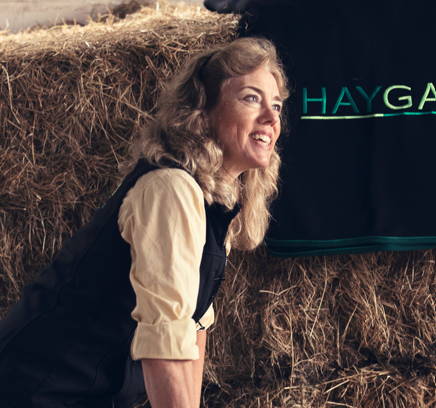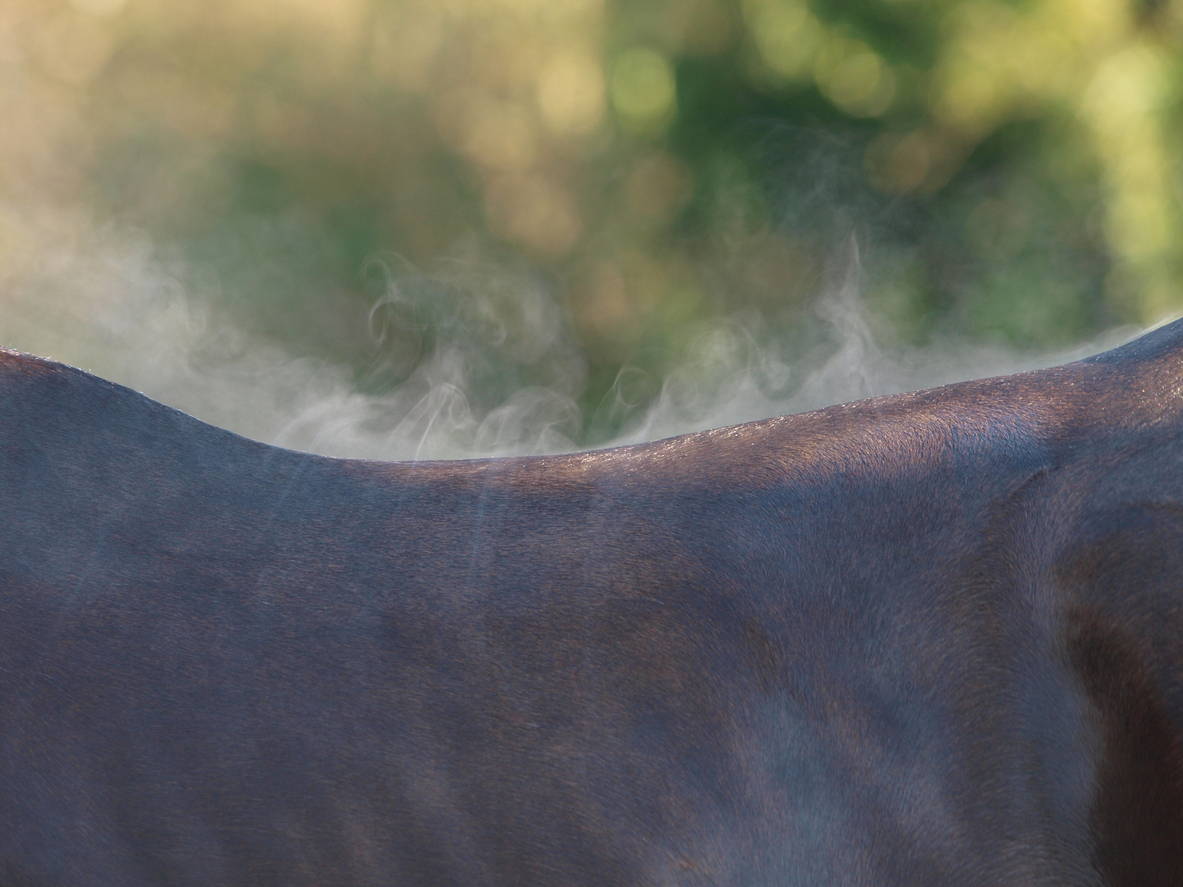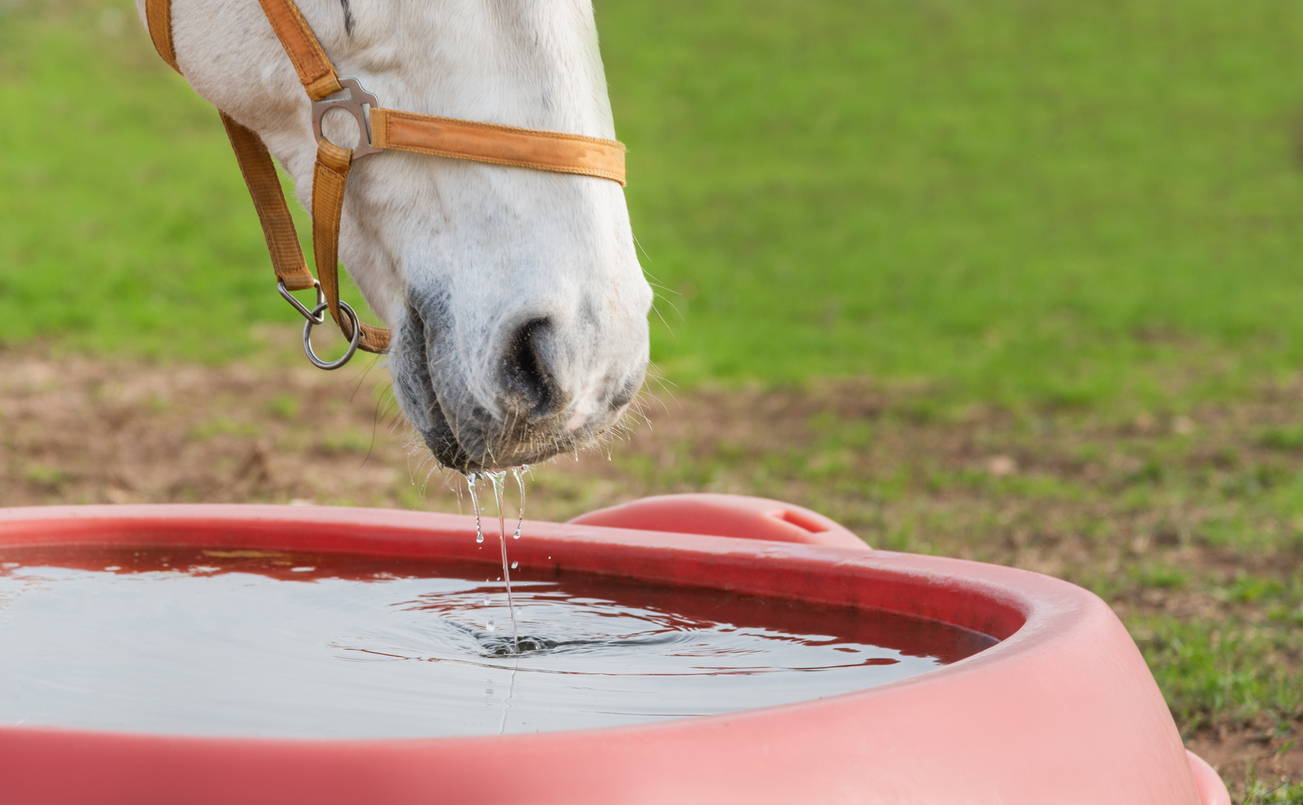Hydration In Horses
Water - How Horses Use, Lose and Replenish this Critical Component of their Diet

By Meriel Moore-Colyer
A horse’s body is made up of 60-65% water so it is not surprising that dehydration can negatively affect performance, health and well-being.
Dehydration causes a loss of physical and mental performance, brought on by the decrease in blood volume, increased use of glycogen as fuel for muscles, and impaired ability to maintain a stable internal temperature (aka “thermoregulation”).
Horses can lose up to 5% of their body weight (25 kg in a 500kg horse) without showing any clinical signs of dehydration, although a drop in performance will be evident.
Dehydration in riders is also an issue. Losses of 5% of body weight (3.5kg in a 70kg rider) cause a 30% loss in performance, so ensuring both of you are adequately hydrated is an easy way to maximize performance1.
Water in the Body
Water is essential for many physiological processes. Two thirds of body water is held inside the cells and one third is held in the blood plasma and gastrointestinal fluid. Water maintains cell rigidity and keeps the red blood cell-to-plasma ratio optimal, so nutrient and gaseous transport can take place effectively.
Water maintains digestive function by carrying enzymes and transporting nutrients in solution. It also plays an essential role in peristalsis – the constriction and relaxation of muscles that helps digesta move through the digestive tract. This enhances the throughput and mixing of feed with microbes to maximize fermentation.
Energy metabolism produces 350-400g of metabolic water/kg dry matter eaten, which can be used for the above processes. To support all bodily functions, your
horse still needs to consume anything from 5-15 gallons per day, depending on work level and climate.
Hydrationstatus is controlled by hormones which respond to electrolyte levels (Sodium = Na;potassium = K; and chloride = Cl) in the plasma. A horse can lose 10g of electrolytesper litre of sweat, so when work levels are intense (fast or long), attentionto water and electrolyte intake is essential. Even short bouts of exercise candrop total body levels of sodium by 8%, potassium by 3% and chloride by 20%.
Electrolytesare required for effective rehydration as they provide the necessary osmolarity (concentration)for water retention in the body in both extra cellular and intracellularcompartments. If your horse will drink electrolytes in water (some will not!) thenrehydrating using a hypotonic solution of electrolytes will hydrate your horse andenhance muscle glycogen repletion. This occurs because water and glycogen areintrinsically linked, with 3g of water accompanying every gram of muscle and liverglycogen stored.
During periods of work, a daily intake of electrolytesis best. I prefer to give them in the feed as they are generally more readilyaccepted than when given in a solution. Whichever way you give the electrolytes,always make sure there is clean fresh water available.
To protect plasma volume during acute episodesof dehydration, 67% of the water held in the cells (intracellular fluid) and inthe gut (transcellular) can be lost --27% goes from the extra cellular space (betweencells) and interstitial space around blood vessels and only 6% from the plasma.This allows horses to move water from one reservoir to another to maintain bodyfunctions2.
After significant sweat loss, like after anendurance ride, it can take 5-10 days to fully replace electrolytes.If you havenot been feeding electrolytes daily or are particularly concerned that acertain competition, climate conditions or a long journey might have asignificant negative impact on your horse, then you can administer apre-exercise dose 4 hours before activity.
As a rough guide on a per-kg liveweight basis, horsescan be given 166mg Cl, 80 mg Na and 16mg K. This can act as a guide to theamount to feed, but generally it is best to use a proprietary blend ofelectrolytes and follow the instructions on the pack. That ensures the correctproportions of each salt are present.
Hydration and Exercise
It is still quite common for racehorse trainers torestrict water before racing in the belief that “a belly full of water” willnegatively impact performance. Others go a step further by giving horses thediuretic Lasix before racing to further reduce body weight and to preventexercise induced pulmonary hemorrhage (EIPH) aka “bleeding.”
Use of Lasix was universal in the USA, but morerecently, its use has been restricted because re-hydrationafter a dose of Lasix can be challenging. It can cause horses to lose thethirst response, which can necessitate veterinary intervention and aggressivere-hydration therapy.
Lasix is banned in UKand its use globally is hotly debated. The performance limiting effect of dehydration can be significantlygreater than the benefits gained from carrying a few less kg, particularlyduring more extended work.
Sweat
All working horses sweat, even in winter time, sowater intake should be monitored throughout the year. Moderate to hard workinghorses commonly lose 10 litres/hour or 10% of body weight.
As horses have sweat glands all over their bodies, theyare very effective thermoregulators. In many situations, the evaporation ofsweat off the coat is so efficient that you may not be aware that your horse issweating. This is often the case in winter and during travelling.

While I generally advocate measuring things before “wading in” with a cure, in the case of dehydration, I assume that working and travelling horses are losing water and I feed a maintenance dose of electrolytes all year round. I increase this level during periods of intense heat (summer), exercise and travelling. Excess electrolytes that are not utilized are readily excreted in the feces and urine, provided the horse has free access to fresh clean water.
Maintaining Water Intake and Hydration
A good balanced diet with free access to cleanfresh water is the main defence against dehydration. Feeding quality fibrehelps with hydration status as the hemicellulose and pectins in the fibre holdwater in the gut. This water can be mobilised for thermoregulation.
When it comes to mitigating against dehydration andencouraging reluctant drinkers to drink, some owners have tried flavouring the water.You might be one of the lucky owners whose horse likes certain tastes, but recenttrials by Filmer (2020) demonstrated that horses preferred plain water to thatflavoured with banana or cherry.
Similarly, some owners try to increase water intake bywetting the bucket feed and soaking the hay. In a recent study by Glatter5feeding soaked hay (69% water content), led to a significantly lowerwater intake of 21.6 litres per day (L/d) compared to those horses consumingsteamed hay(32% water content) of 30.3 L/d or dry hay (85% DM) who drank 32.3 L/d.
So, it seems that innate physiological processes ofthe horse control water intake and we cannot influence this by stimulants like smell,taste or texture. Thus, the old saying of “You can lead a horse to water, butyou cannot make it drink’ holds true.”
Measuring Dehydration
Ifyou are concerned that your horse may be chronically dehydrated due toexcessive sweating, diarrhea or not drinking enough, then monitoring water intakeis a good idea. You will need to take account of water consumed by drinking andeating, so you need to know the dry matter content of the diet.
Workby Pritchard3 has shown that monitoring water intake in terms ofnumber and duration of drinking bouts is the most reliable measurement ofhydration status. Arough guide to how much water your horse should be drinking, ranges from 2.5 to3.5 l/kg of diet dry matter, depending on the type of diet they are eating.
Estimatingoutput can be more difficult. The normal medium and amounts of water excretedare: feces (51%), urine (18%) and insensible losses- sweating, respiration(31%). These proportionscan alter quite a bit according to health status, environmental conditions andsweating.
Again, as a rough guide and depending on environmentalconditions and work intensity, horses produce 10 to 35ml of sweat/m2of skin/min, so the total amount of sweat your horse will lose depends on itssize.
Diagnosing dehydration has traditionally been doneusing the pinch test (pinch an inch of skin on the neck and count how manyseconds it takes to return to normal) or assessing the dryness of mucousmembranes, but Pritchard3 showed that these methods were poorlycorrelated with plasma osmolarity.
However, other studies4 have shown thathorses can lose plasma volume without showing any change in plasma osmolarity,so the current practical tests are a guide only, and not a definitivediagnostic tool.
The best way to avoid dehydration isalways ensure you horse has a supply of fresh water and that electrolyte levelsin the diet are adequate. The best way to do that is to have allthe feed analysed for mineral content. Be aware that hot weather, exercise andexcitement can cause significant losses of fluid and electrolytes.
If you are not routinely feeding the electrolytes, then please start now. Prevention, in the caseof dehydration, is an easy and cheap fix.
When thinking about your horse, don’t forget aboutyourself. Competition conditions in summer, with the nerves and full regalia(inclusive of black jacket!) can significantly increase your susceptibility todehydration, so buy some electrolyte drinks and keep them close at hand forthose days.
Author Meriel Moore-Colyer is an equinescience professor at the Royal Agricultural University in the UK.
Studies Referenced
1 Jeukendrup, Asker, and Michael Gleeson. (2015) “Dehydration and Its Effects on Performance.” Humankinetics. N.p., n.d. Web. 29 July
2 Sneddon, J. Van der Walt, J. Mitchell, g. (1993) Effect of dehydration on the volumes of body fluid compartments in horses. Journal of Arid Environments 24. 397-408.
3 cxvJ. C. Prichard, CC Burn, ARS Barr, HR Whay. (2008). Validity of indicators of dehydration in working horses: A longitudinal study of changes in skin tent duration, mucous membrane dryness and drinking behaviour. E.V.J 40(6) 558-564doi: 10.2746/042516408X297462
4 Coenen, M. (2005) Exercise and stress: impact on adaptive processes involving water and electrolytes. Livestock Production Science 92. 131-145
5 Maren Glatter, Mandy Bochnia, Monika Wensch-Dorendorf, Jörg Michael Greef and Annette Zeyner (2021)Feed Intake Parameters of Horses Fed Soaked or Steamed Hay and Hygienic Quality of Hay Stored following Treatment. Animals 11. 2729.





















